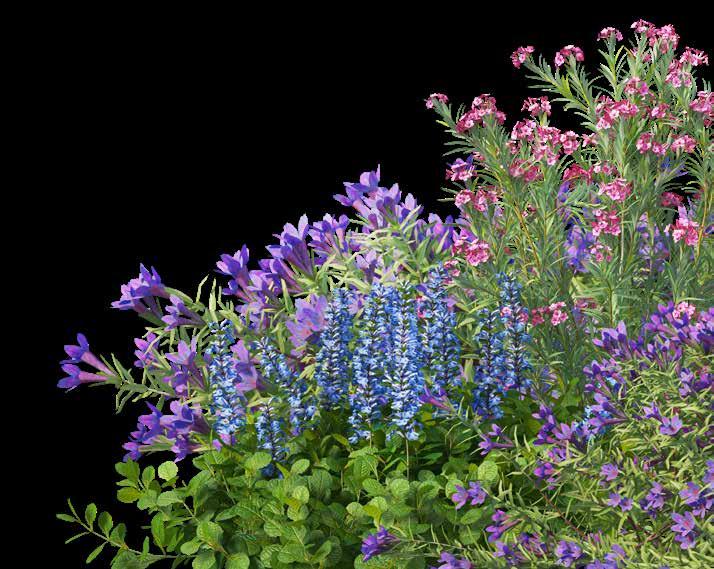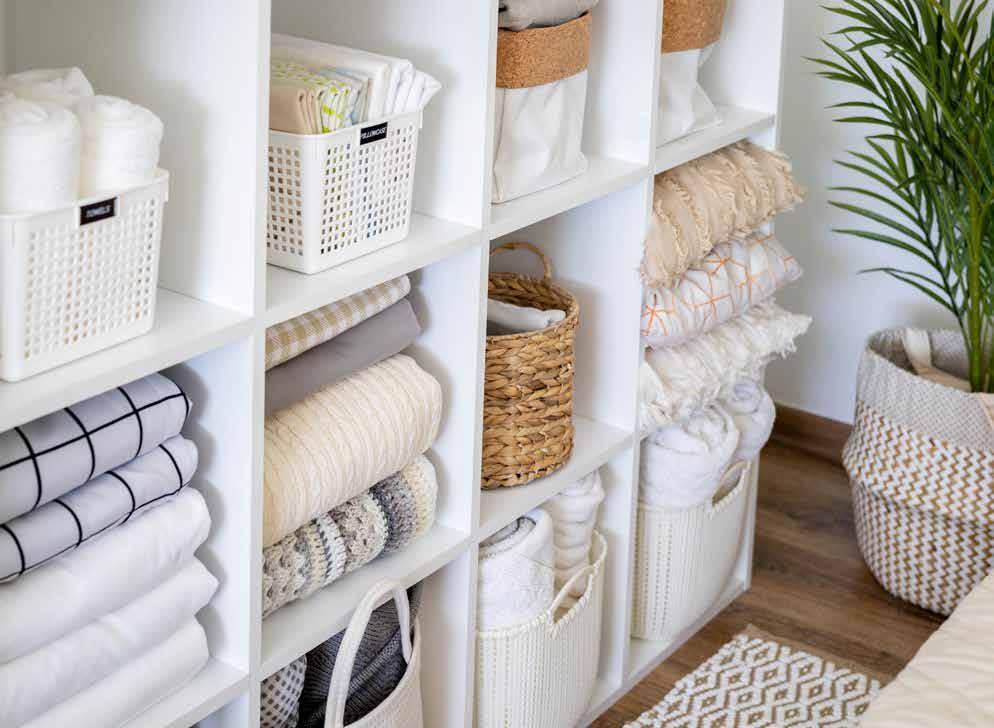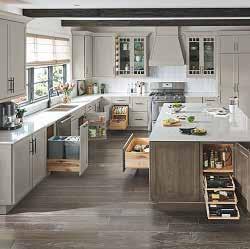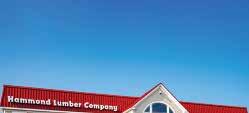Home IMPROVEMENT & LANDSCAPING









BY STEPHANIE BOUCHARD
There’s something particularly enjoyable about bark mulch in the landscape, said Caleb Davis, landscape designer and owner of Songscape Gardens, a landscape design and build company in Bar Harbor.
“I remember getting great satisfaction out of a nice, very neat, clean garden that’s freshly mulched,” Davis said. But Davis, like many gardeners, has come to appreciate a more richly planted and layered landscape created with green mulch.
Green, or living, mulch is a layer of plants under taller plants, trees, and shrubs taking the place of bark mulch in the landscape. Think hay scented ferns under trees. Like bark mulch, green mulch works to suppress unwanted plants (sometimes called weeds, depending on your perspective) and retain moisture, but it offers additional benefits that increasingly appeal to home gardeners, say Davis and Cathy Rees, cofounder and executive director of Native Gardens of Blue Hill.
GARDENERS PLANT ONCE INSTEAD OF HAVING TO
PURCHASE BAGS OF BARK MULCH AND APPLY THOSE TO THEIR LANDSCAPES EVERY YEAR.
From a practical perspective, using a living mulch that’s matched to the landscape conditions means less work for gardeners over time, said Rees. Gardeners plant once instead of having to purchase bags of bark mulch and apply those to their landscapes every year. Once established, green mulch is mostly self-sustaining, needing few, if any, interventions from gardeners.
A living mulch also gives gardeners the opportunity to accomplish one of their favorite things: putting more plants in their gardens. And, depending on the plants chosen, can provide additional interest in the garden, said Davis. Consider, for example, sedges or phlox planted under peonies that bloom when the peonies are not in flower.
“Plants have evolved to grow in community with each other and plants are, for the most part, happier in that type of situation,” Davis said. “You can definitely underplant a tree with perennials and grasses or sedges in a way that’s beneficial to the tree. They’re not going to be competing for resources, but instead actually sort of providing a mutual benefit. That’s what we see in nature.”

Like in the wild, an ornamental garden using a green mulch becomes a multilayered landscape that not only is pleasing to the eye but supportive of life.
“You’re sort of expanding the area of food and habitat available for pollinators and insects,” Rees said, “and then subsequently, food for mammals and birds on up the food chain.”
Planting a green mulch is not as simple as spreading 10 bags of bark mulch around perennials in the garden. Selecting specific plants and combining them appropriately are key to creating a successful living mulch, say Davis and Rees.
“There’s definitely a lot of benefit to understanding the situations in which plants have evolved and using plants accordingly,” Davis said.
Using native plants for a living mulch is a great idea simply because they’ve evolved to thrive in our landscape and in tightly knit communities, which make them ideal as a green mulch as they won’t
be subject to fungus or disease. That said, green mulches don’t require the use of native plants, Davis said, so gardeners can explore and experiment.
When selecting plants for green mulch gardeners should match the plants to the site conditions, Rees said. Plant guides, like the one in the resources section of Native Gardens on Blue Hill’s website, provide information about the soil conditions specific plants thrive in.
Home gardeners can also talk to their local garden centers for advice, or hire a professional who has experience in designing landscapes with ecological horticulture principles. There are also a number of good books and online resources.
Davis recommends Roy Diblik’s book “The Know Maintenance Perennial Garden” and Thomas Rainer and Claudia West’s book “Planting in a Post-Wild World.” Both are good resources for home gardeners wanting to experiment with living mulches.



Trends that seem ubiquitous one day can seemingly vanish before the sun rises again just 24 hours later. That's especially true in the digital age, when overnight celebrities and viral videos can be on the tips of everyone’s tongue before being forgotten entirely when the next online sensation emerges in an increasingly rapid news cycle.
Home trends typically benefit from a longer shelf life than viral videos and other fads that originate on the internet, and that’s something renovation-minded homeowners should consider when improving their homes. Homeowners preparing to do just that can consider these notable trends, which the online renovation experts at Houzz suggest will be particularly popular in the year ahead.

· ROUNDED FURNISHINGS: Houzz noted that gentle curves and rounded edges embody the organic modern styles that many current homeowners love. Rounded dining tables and similarly circular coffee tables may merit consideration among homeowners who want to embrace popular trends.

· ARCHES: Houzz cites arches among the more popular modern trends, and the experts at Better Homes & Gardens note this unique, eye-catching style has been gaining popularity for several years. Better Homes & Gardens suggests that part of the appeal of arched doorways could be their deviation from a more traditional door shape. That uniqueness draws the attention of residents and visitors alike, and Houzz notes that arched windows, cabinets and even millwork details are part of the pivot toward arches.
· STOVE ALCOVES: If it’s a touch of history homeowners want, kitchen range alcoves might be just the project for them. Range alcoves call an earlier time to mind when wood burning stoves were commonplace. The report from Houzz notes range alcoves immediately draw attention, which undoubtedly adds to their appeal.

· WOOD FOR WARMTH: Homeowners who hear “wood and warmth” might think fireplaces, but Houzz reports that wood elements are being incorporated into interior designs as a means to giving homes a more cozy vibe. Ceiling beams, trim, wall paneling, and cabinetry are utilizing wood to add warmth to a home.
Trends come and go, but home trends typically have more staying power than styles that emerge in other arenas. Homeowners who want to upgrade their home interiors can consider the latest trends and choose those that align with their own personal tastes.

As Maine’s winter winds howl outside your windows, have you noticed drafts making their way inside? Or perhaps you’re already thinking ahead to those spring and summer renovation projects? Your windows and doors are more than just functional necessities—they're an investment in comfort, energy efficiency, and lasting beauty.
At Renewal by Andersen of Greater Maine, our commitment to excellence begins with our exclusive Fibrex® material—a revolutionary composite that outperforms traditional window materials in virtually every category. Unlike vinyl windows that can warp, crack, or fade over time, Fibrex® maintains its structural integrity through Maine's harshest weather conditions. This remarkable material allows for narrower frames and more glass area, maximizing your views while maintaining superior insulation properties. And unlike competitors’ limited options, Fibrex® can be customized in our complete line of designer colors to perfectly complement your home’s aesthetic.
What truly sets Renewal by Andersen apart is our exceptional service and complete ownership of the process from start to finish. While many companies outsource various stages of window replacement, we handle everything ourselves—from manufacturing our products in the United States to installation by our certified master installers.
Each window and door is custom-measured and tailored specifically for your home, ensuring a perfect fit that maximizes energy efficiency and performance. This attention to detail and quality control at every stage is why homeowners across Maine trust us with their homes.
Maine is a vast state with varying architectural styles. We proudly serve homeowners from the Lewiston/Auburn area all the way to Fort Kent, bringing our superior windows and doors to residents throughout the entire state. Our teams understand the unique challenges of Maine's climate and the specific needs of homes throughout Maine.
During these cold winter months, energy-efficient windows aren’t just about comfort—they’re about saving money. Our custom-fitted windows create a tight seal that significantly reduces air leakage, helping to lower heating costs immediately and cooling costs when summer arrives. By scheduling your window replacement now, you’ll not only improve winter comfort but also position yourself ahead of the spring renovation rush. Many homeowners don’t realize that winter is actually an excellent time for window installation, as our professional teams are specially trained to complete installations in any weather.
We stand firmly behind the quality of our work with one of the strongest warranties in the industry. Our comprehensive warranty covers not just the windows themselves, but the installation as well—providing you with complete peace of mind for years to come. This commitment to lasting quality is the embodiment of our promise: Superior Products. Exceptional Service.

























BY CRYSTAL SANDS

The colorful beauty of flower gardens adds something special to any home’s landscaping. In addition to improving your home’s value, flower gardens bring a charm that makes them well worth the time, work, and investment.
Marie Sekera of Eddington is a retired teacher and landscaper who ran a landscaping business in the Bangor area for 10 years. She continues to consult with family and friends who are seeking to use flowers to enhance the beauty of their homes. She also continues to keep many gorgeous flower gardens around her home.
Sekera said there is a lot to consider when choosing plants for your flower garden, but a good place to start is to think about what works well in our region.
“It would be wise to get native plants because they are indigenous, and you’ll have better luck,” Sekera said.
Native plants may be a little less “showy,” but there are plenty that will give you color and will be less susceptible to bugs and diseases. Native plants have become so popular that they are easy to find locally, Sekera said.
Rebel Hill Farm in Liberty specializes in Maine native plants, and their plants are available in the Bangor area at Tiller & Rye in Brewer, as well as Sprague’s Nursery in Bangor. Hutching’s Greenhouse in Eddington is also a great place to purchase reliable, healthy plants.
A mix of perennial plants, which live for multiple growing seasons, and annuals, which live for just one growing season, can be used to create color throughout the spring, summer, and fall. When purchasing plants, it’s important to study when the flowers will bloom, and if you plan well, you can have color in your gardens throughout the growing season here in Maine.
It’s important, however, to remember that it’s not just flowers that can bring color.
“I’ve learned to appreciate foliage shape and color as much as the flowers,” Sekera said.
There are many native plants that will bring variety and color to your gardens at different times of the year, so it’s not just about the blooms when you make your plans for color.
Once you have considered color, it’s important to think about where you will plant. Sekera said it’s good to remem ber the “rule of three” when planting. Planting in groups of three is visually appealing and mimics how plants will naturally group in the wild. Of course, one of the most im portant considerations when it comes to location is sun light. Different plants require different amounts of sun — full, partial, shade — and in order to have success, sunlight requirements for your plants will be crucial.
There is much to consider when planning for your garden. It takes some research to make good decisions. Your gardens will need weeding and care, but working in the dirt is both healthy and rewarding. And, at the end of the day, you can have beautiful gardens that will bring joy to yourself and others.
Sekera said to remember that gardening is a process of learning. Failures are not really failures but are more teaching experiences. Sekera emphasized that the science and beauty of the flowers makes the work completely worth it.














$5 AT THE DOOR KIDS 12 & UNDER FREE!




The Great Home Expo Returns to Bangor for Its Fourth Year!
Exciting news for homeowners, DIYers, and anyone looking for home improvement inspiration—the Great Home Expo 2025 is back for its fourth consecutive year! Sponsored by Hammond Lumber Company, this must-attend event will take place at the Cross Insurance Center in Bangor from April 4-6, bringing together the best of Maine’s home and outdoor living businesses under one roof.
The Great Home Expo is the perfect opportunity to explore a wide range of home improvement solutions, from new builds and renovations to backyard makeovers. With exclusive event-only pricing, expert advice, and face-to-face connections with top local businesses, attendees can confidently plan their next project.
Entry for this event will be through the Renewal by Andersen Entrance, with admission priced at just $5 per person (kids 12 and under enter free). Attendees can also enter fora chance to win one of two $250 Visa gift cards, generously provided by Bangor Savings Bank.
Friday, April 4: Noon– 6pm
Saturday, April 5: 10am– 6pm
Sunday, April 6: 10am– 3pm
In addition to home improvement exhibits, this year’s expo will feature Jurassic Encounters,an interactive dinosaur exhibit that’s sure to delight kids and families. Pine State Recreation will also showcase its outdoor playground equipment, offering hands-on fun for the little ones. And of course, no event is complete without great food! Attendees can enjoy fresh popcorn, hot pizza, and cold drinks from the venue’s concessions—just remember that the venue is cashless for all food and beverage purchases.
The Great Home Expo is made possible thanks to the support of local businesses and sponsors who are dedicated to serving the Maine community. This year’s event is proudly presented by Hammond Lumber Company for the fourth consecutive year, with additional sponsorship from Harvey RV& Marine, Renewal by Andersen of Greater Maine, and Coastal Concrete Coating.
If you’re looking for inspiration, trusted professionals, or simplya fun way to spend the weekend, The Great Home Expo is the place to be Come out, support local businesses, and turn your home improvement dreams into reality!
Jess Pearl
Owner/Event Director, Great Home Expo
















Change is in the air when a new year arrives. People often use the turn of the calendar as an opportunity to redecorate living spaces or revamp their wardrobes. As individuals narrow down their projects, they may want to incorporate a fresh and trendy palette of colors. For 2025, the options are decidedly warm, cozy and earthy.
Industry color experts routinely recommend hues that can elevate homes, offices and other spaces. The following is a selection of shades that insiders predict will color the world for the coming year.
Sherwin-Williams has named Quietude its color of the year. This soft sage color exudes serenity and understated luxury. Grayish-green with a touch of blue, Quietude is a soothing color of tranquility. Sherwin-Williams also offers a Color Collection of the Year that includes Convivial Yellow, Spiced Cider, and Nomadic Desert, among others.
The title of Pantone® Color of the Year 2025 belongs to Mocha Mousse. Just as the name implies, this rich, warm brown suggests the intoxicating qualities of coffee and chocolate. It can create a feeling of comfort in any space, or even serve as the basis of a chocolate wardrobe color palette.
Glidden’s 2025 color of the year title belongs to Purple Basil, a dusty, neutral violet purple hue with mauve undertones. It embraces rich, warm energy, and is equally at home in a bedroom as it is in a dining room.
Cinnamon Slate is moody and introspective. This Benjamin Moore color blends rich plum and chocolate brown that the compa -
ny calls "adaptable, yet distinct." In fact, it is quite similar to Glidden's color of the year, but a tad more brown in nature.
Homeowners may want to consider Caramelized, an earthy terracotta brown that is Dunn-Edwards' 2025 Color of the Year. Caramelized is versatile and elegant, and it complements both modern and vintage interiors.
Paula Taylor, Graham & Brown’s head stylist and trend specialist, calls Elderton “a chameleon color that can be sophisticated yet cozy.” This medium brown is contemporary with a huge amount of depth. It may work in a rustic living room or a cozy library.

















BY KATIE SMITH

Does the thought of cleaning out cupboards, organizing your garage, and revamping the closets to make more space get so overwhelming you walk away just minutes after you get started? That’s what happens to 95 percent of people when they start the daunting task of figuring out what to keep, what to donate, and how they are going to stay organized. Everyone dreams of opening up a closet and finding the exact shirt they’re looking for or having a special place for every necklace.
As a professional personal organizer, I’ve seen it all: food stored in the bathroom because of a lack of pantry storage, clothing stored in the garage, and shoes kept under the coffee table. Of course there’s nothing wrong with any of these methods, but the thing is, most people don’t enjoy living this way. It bothers them to not have a rough room and too much clutter because let’s be honest, no one has the time to manage it all.

1.
If you’re committed to getting and staying organized, I can help. And I promise, it doesn’t have to be painful. Here are tips that will make your cleaning and organizing journey pain-free.
Doing something you’re dreading is so much better when done with a friend or family member. Maybe you have someone in your circle who is


brutally honest and will push you to get rid of some things. Or maybe they’ll just lounge on your sofa or bed to keep you company while you do all the work. Even that can be better than going it alone. It’s always helpful to bounce ideas off another person. Don’t forget to provide good snacks!

2. SCAN PINTEREST OR YOUR FAVORITE MAGAZINES
Nothing gives us inspiration like looking at another amazing space. It can give you fuel to tackle your main closet, get those glass jars with the bamboo lids for your pantry, or order shoe organizers. Start a vision board of organized spaces you love, and look at it often. It will ignite your inner-organizer. I promise.
3. ANALYZE EACH ROOM AND MAKE A LIST OF ALL THE THINGS YOU DON’T WANT TO SEE
This step is so important because it will keep you focused while you work. Look at each room before you get started. What’s your vision? What do you want the room to look and feel like? What items do you want to hide or keep



somewhere else? Maybe you have a finished basement that’s a home gym, but it’s become a catchall for old furniture. Make a list of everything you don’t want to see any longer, and a list of what you would like in that room.
4. START IN ONE ROOM AND COMPLETE IT BEFORE YOU MOVE TO THE NEXT.
Trust me on this. I know it’s easy to get sidetracked. But the number one reason I see people lose steam when they are trying to organize is because they start in one room, pull another room apart, feel like they aren’t making progress, then they quit. Yes, you will make a bigger mess before you see progress, but the trick is to stay focused on one room and complete it so you will see the difference your hard work is making. That will motivate you to move to the next room because you’ll love how you feel when you’re in your organized space, and you’ll want to carry that feeling in every room of your house.
5. MAKE 4 PILES: KEEP, STORE, DONATE, TRASH
Go through your things and put them in piles first. Don’t
go through things one item at a time. Pull it all out so you can see what you have. This helps because you may have duplicates of something you don’t need, and if you don’t have it all in front of you, you may forget and you’ll spend precious time backtracking and looking for things. Once all the drawers, closet, or shelves are cleared off, scrub them down, then organize and put away all the things you want to keep. If you have a storage unit, or another place where you want to store items, get that done, then drop off all items you’re going to donate, and throw all trash away.
6. INVEST IN SOME PRETTY CONTAINERS AND ORGANIZERS.




This helps make the project more fun. Who doesn’t love pretty containers or baskets to hide their stuff in? That pile of mail you can’t seem to get rid of looks much better in a sleek organizer, and finding utensils is so much easier when you invest in a flatware organizer.
Need more help? Find Katie’s Kozy Homes on Facebook.





























This time of year, when the days are short and the months are long, few things are more hopeful than sitting down with a hot mug of tea and slowly flipping through a seed catalog. There’s something about the promise of bright red tomatoes, plump blueberries, jewel-toned flowers, and verdant landscapes that makes late winter’s
wind and cold more tolerable. As the light begins to change and you find yourself staring at page after page of possibility, something takes root within you. It’s time to start planning your garden!
We’re lucky to live in a state with a rich tradition of home gardening, but the prospect of planning can feel daunting, even for those who have done it many times

over. Most public libraries have a section of gardening resources to get you started and some even host small seed libraries, where patrons can swap seeds and learn from each other throughout the year.
But, if you can’t find what you’re looking for locally, there’s always the internet. It was there, as I was weeding through how-to gardening videos on YouTube, that I stumbled across the University of Maine’s Cooperative Extension channel. Broadly speaking, the extension’s mission is to help connect everyday people with research-based information on topics ranging from gardening to beekeeping, food safety and preservation, youth development, and more. Despite being the university’s largest outreach branch and racking up thousands of views on their videos, I felt like I’d discovered hidden treasure.
“If you add ‘UMaine’ to almost any gardening question you have, there’s a good



BY EMILY BAER
chance we have a relevant resource,” says horticulturalist Kate Garland, who works in the Penobscot County extension office. Garland and her colleagues make sure of it. “I love helping people find practical and often simple strategies to meet their horticultural goals.”





Beyond free online videos, the cooperative extension offers resources on a variety of Maine-based topics and in a variety of formats. Some are educational, like the Victory Garden for ME course that helps gardeners of all experience levels with everything from garden planning to soil prep to harvesting and food preservation tips. There’s also a Pollinator-Friendly Garden Certification for those interested in providing food, habitat, and water to support pollinators, and webinars that explore topics like home orchards and planting native species. Garland and her team also produce a free newsletter, Maine Home Garden News, that includes monthly to-do lists, timely how-to articles, important updates on pests and diseases, and interesting articles on related topics, such as the Backyard Bird series by Maine Audubon. But more than just providing information, the cooperative extension also helps connect communities.
“We offer a variety of in-person workshops throughout the state, and staff in many of our county offices are available to support individuals with their gardening questions,” she explains. And, as gardeners get comfortable, they turn to each other for help. “Witnessing the greater
horticultural community supporting one another is a wonderful part of the job.”
Many of the extension’s offerings are free and easy to find online, and their in-person programming runs throughout the year.
“Gardening is a year-round process! I never stop planning and checking out new resources,” Garland says.
So, once you’ve picked out some seeds and finished your tea, grab a notebook and get to work. Here are some helpful tips to help get you started.
START SMALL. “Think carefully about how much time you want to commit to gardening before making any big decisions,” Garland says. “A large vegetable garden may seem lovely in the winter months, but requires (at least) weekly attention throughout the entire growing season.” The same holds true for houseplants.
PACE YOURSELF. As with anything, you win some and you lose some. “Some
of the greatest gardeners have killed a lot of plants.” Expand your efforts when you're able.
KNOW THYSELF… AND
DEN. One of the most important steps you can take is to get to know your site conditions. Be sure to pick your plants based on your location and its unique characteristics. The extension offers soil testing and insect identification services to help.
AS YOU GO. Garland recommends taking lots of pictures of your garden as it grows. Detailed notes can also be quite valuable. “I look back at pictures of our gardens all the time to inform my future plans,” she says. “This includes documenting both the good and not-so-good things.” It’s all part of the journey.
TEAMWORK MAKES THE DREAM WORK. Your gardening goals will be specific to your life’s needs, so consider

bringing friends and family along as you start planning. Their perspectives may be helpful, and you can always use an extra pair of hands in the garden.
ASK FOR HELP. The cooperative extension’s resources are designed for all experience levels. “In horticulture, there's so much to learn, so many new things to try and experience, and countless gardens and fellow gardeners to be inspired by,” Garland says.
LEVEL UP WHEN YOU’RE READY.
If you feel like it’s time to really dig in, the extension offers three major training programs for advanced gardeners. There’s the Maine Master Gardener Volunteer training, the Maine Horticulture Apprenticeship Training, and the Maine Gardener program. Each is designed with specific goals in mind, so if you’re curious, call your local county office. You’ll be amazed by what you learn!











